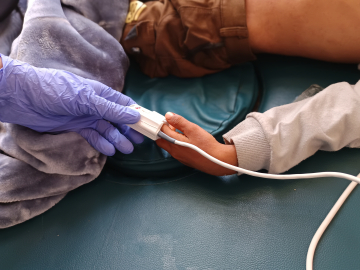Time to Act: WHO’s New Snakebite Strategy
Start the clock. After 24 hours, some 7,400 people will have been bitten by snakes, and 220 to 380 of them will die.
That means 81,000 to 138,000 deaths every year. And 400,000 serious injuries such as amputations. But those are just estimates. No one knows how many people are bitten by snakes and or how many die each year. Farmers in their fields, children playing outside, women sleeping in their homes… 5.8 billion people are at risk of coming across a venomous snake.
Long recognized as a threat to health yet under-prioritized for just as long, snakebite envenoming has recently surged in prominence on the global health agenda. After a resolution at last year’s World Health Assembly, the WHO added snakebite envenoming to its list of neglected tropical diseases and began developing a strategy against it. (WHO defines snakebite envenoming as the potentially life-threatening disease that follows the injection of toxins from a venomous snake bite.)
The strategy seeks to halve snakebite deaths and morbidity by 2030.
Then the Wellcome Trust stepped up to support the strategy with a $100 million investment announced on May 16. (The funding was deemed “very, very welcome” by Mwelecele Ntuli Malecela, director of WHO’s Department of Control of Neglected Tropical Diseases,” in her keynote address.”)
And yesterday, the WHO officially launched the strategy during the World Health Assembly. At the event, many of the ambassadors, ministers of health and experts from within and outside the WHO shared in what seemed to be genuinely giddy excitement.
A real global response to a pernicious threat to health finally was underway.
“With this strategic roadmap, we begin a journey to translate results from this framework of cooperation,” said Elayne Whyte Gómez, Costa Rica’s ambassador to the UN in Geneva. “We are living the principal and promise of international cooperation.”
The power of global cooperation will be needed to resolve some major knowledge gaps, said Soumya Swaminathan, WHO’s newly named chief scientist. “We have a lot of work ahead of us,” she said.
Research is urgently needed into to accurately quantify the burden of snakebite and the number of deaths and to understand issues with antivenom. Swaminathan said the quantity and quality of antivenom has decreased in recent years though manufacturers are now trying to make more effective antivenom. Experts in proteomics, genomics and other fields will be needed to find new antivenom solutions and define new target profiles for products, she said.
Research will also be needed to understand community attitudes and beliefs about snakebite and post-bite care as well as strategies for successfully engaging communities around the issue.
Malecela emphasized the role of stronger health systems to reduce the global toll of snakebite. She also cited the need to build up stockpiles of antivenom and to enhance partnerships around the challenge.
“We passed a resolution to work on snakebite envenoming in more meaningful way which is now marking a very strong turning point in history of public health and snakebite,” Malecela said.
She closed her keynote by quoting Victor Hugo who said, “Nothing is stronger than an idea whose time has come.” Nothing is more important than tackling snakebite, she said.
“Our time to act has started now,” Malecela said.
Ed. Notes: Check out the latest news from #WHA72 here.
Join the tens of thousands of subscribers who rely on Global Health NOW summaries and exclusive articles for the latest public health news. Sign up for our free weekday enewsletter, and please share the link with friends and colleagues.
An Indian snake catcher—whose skills are crucial for the production of anti-venom—displays the fangs of a Russell’s Viper at a venom extraction center in Chennai on November 11,2016. Arun Sankar/AFP/Getty Images





